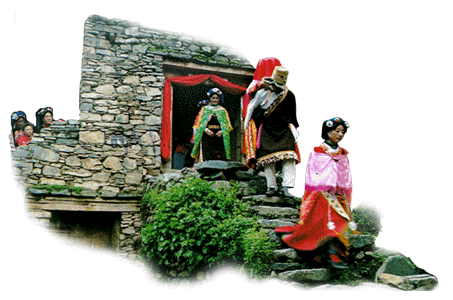






| In the early morning, the groom's wedding party comes
to invite the bride for the wedding ceremony. Very possibly, we guess,
the groom is confined in his own place waiting for his task. Guided
by her chaperone, the bride is carried, in the "piggy-back" style, through
her village gate by her older brother. If the bride doesn't have
any brother, she can pick someone as the brother figure for the wedding.
Her wedding party, her close friends and relatives, escort them to the
wedding ceremony. The scene is very animated, both by music, and
by the crying of the bride and her female companions, who are reluctant
to see the bride leaving, on one hand, and happy for her, on the other.
Tears and music compose the symphony of their endearments.
As the bride is taken away, her villagers line up along their way and
sing:
"Please put your hearts at ease
Back and forth, all people from both villages sing their caring and blessings. Notice that the bride's head is already covered with a red veil, and that her feet do not touch the ground when she leaves her village. This signifies a total devotion of the bridal families to assist the bride's adaptation to her new family and new life. In order to have a new start and to better prepare her, it takes efforts and determination. This is difficult for her, her family members, her friends, and her village folks. Many cultures have variations of these practices. What are the similar practices in your own culture? |